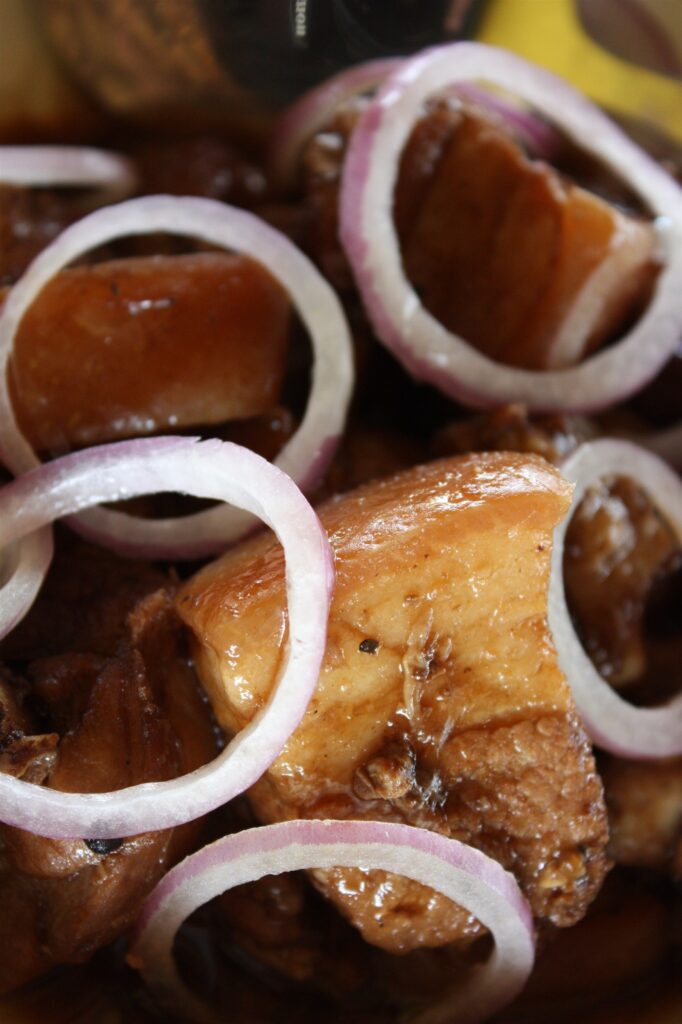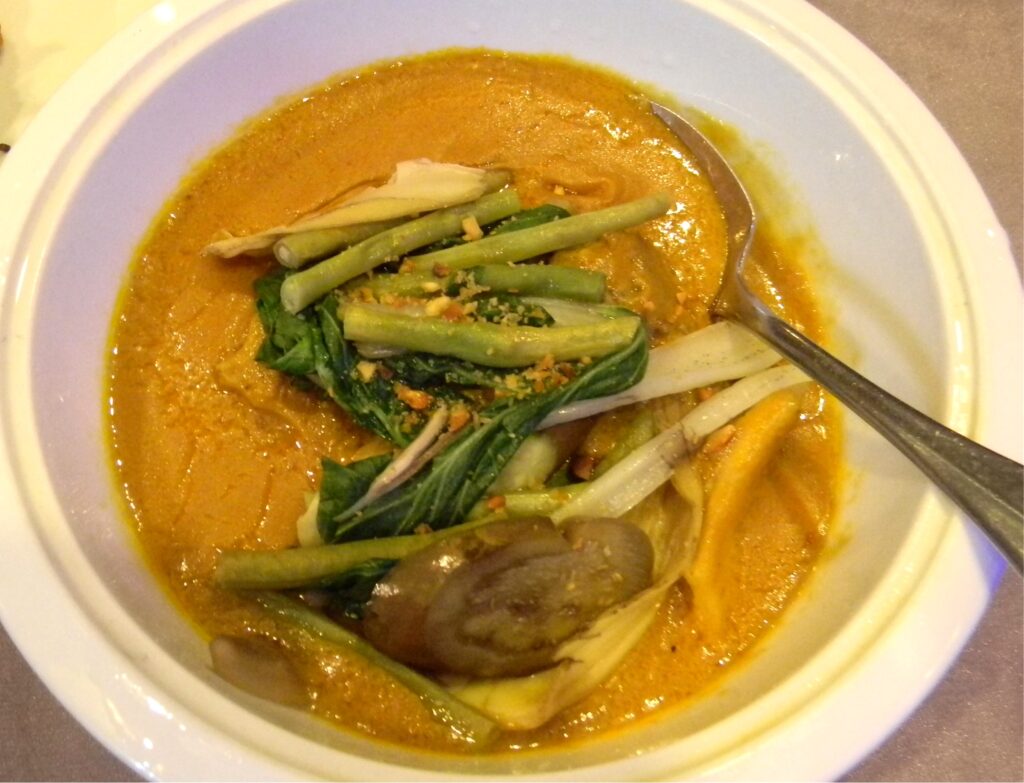Text and Photos by Henrylito D. Tacio
Human beings are omnivorous by nature. They have hunted and killed animals for meat since prehistoric times. The advent of civilization allowed the domestication of animals such as chickens, sheep, pigs, and cattle, and eventually, their use in meat production on an industrial scale.
Meat is the animal flesh that is eaten as food. All muscle tissue is said to be very high in protein, containing all of the essential amino acids, and in most cases is a good source of zinc, vitamin B12, selenium, phosphorus, niacin, vitamin B6, choline, riboflavin, and iron. Muscle tissue is very low in carbohydrates and does not contain dietary fiber. The fat content of meat can vary widely depending on the species and breed of animal, the way in which the animal was raised, including what it was fed, the anatomical part of the body, and the methods of butchering and cooking.
Meat is usually eaten together with other food. It is edible raw but is normally eaten after it has been cooked and seasoned or processed in various ways (e.g., curing or smoking). Unprocessed meat will spoil within hours or days.
“The spoilage of meat occurs, if untreated, in a matter of hours or days and results in the meat becoming unappetizing, poisonous or infectious,” notes Wikipedia. “Spoilage is caused by the practically unavoidable infection and subsequent decomposition of meat by bacteria and fungi, which are borne by the animal itself, by the people handling the meat, and by their implements.”
Meat can be kept edible for a much longer time – though not indefinitely – if proper hygiene is observed during production and processing and if appropriate food safety, food preservation, and food storage procedures are applied.

Adobo 
Kare-kare
“There are a number of ways by which the storage life of meat is lengthened,” notes The Philippines Recommends for Meat Processing. “The most common methods of meat treatment are cold storage, salting, curing, drying, smoking, and canning.”
In other words, meat is being processed. Meat processing is defined as any mechanical, chemical, or enzymatic treatment of meat that alters the form from which it initially occurs.
“There are economic, dietary and sensory aspects that make meat processing one of the most valuable mechanisms for adequately supplying animal protein to human populations,” wrote Gunter Heinz and Peter Hautzinger, authors of Meat Processing Technology for Small- to Medium-Scale Producers, published by the UN Food and Agriculture Organization.
The two authors cite the following reasons:
• All edible livestock parts that are suitable for processing into meat products are optimally used. In addition to muscle trimmings, connective tissue, organs, and blood, this includes casings of animal origin that are used as sausage containers.
• Lean meat is one of the most valuable and most costly foods and may not regularly be affordable to specific population segments. The blending of meat with cheaper plant products through manufacturing can create low-cost products that allow more consumers access to animal protein products. In particular, the neediest children and young women from low-income groups can benefit from products with reduced but still valuable animal protein content that supply essential amino acids and also provide vitamins and minerals, in particular iron.
• Unlike fresh meat, many processed meat products can be made shelf-stable, which means that they can be kept without refrigeration either as (1) canned heat sterilized products, or (2) fermented and slightly dried products or (3) products where the low level of product moisture and other preserving effects inhibit bacterial growth. Such shelf-stable meat products can conveniently be stored and transported without refrigeration and can serve as the animal protein supply in areas with no cold chain provision.
• Meat processing “adds value” to products. Value-added meat products display specific flavor, taste, color, or texture components, which are different from fresh meat. Such treatments do not make products necessarily cheaper; on the contrary, in many cases, they become even more expensive than lean meat. But they offer diversity to the meat food sector, providing the combined effect of nutritious food and food with excellent taste.
Processed meats are classified as either non-comminuted or comminuted. Non-comminuted includes hams, bacons, corned beef, and those intact cuts of meat that are cured, seasoned, heat processed, and smoked.
Comminuted products use small meat pieces, chunks, chips, or slices. Most comminuted products are classed as sausages. Sausages can be called as fresh when they are made from fresh meats, and they are not cured, smoked, fermented, nor cooked.
Uncooked smoked sausages are fresh sausages that are cured and smoked at a temperature of 32ºC for three hours. Cooked, smoked sausages are a type of sausages that are subjected to light smoking and cooked at an internal temperature of at least 61ºC.
There are also cooked meat specialties (sausages which are formulated and processed), fermented dry sausages (type of sausage which requires the action of microorganisms for the production of lactic acid), and semi-dry sausages (those sausages which are smoked and dried for a short time at high temperature).
In the Philippines, most of the meats being processed are pork, beef, and chicken. Recently, chevon or goat meat has been added to the list. In Cagayan Valley, chevon is canned and prepared into three traditional recipes: kaldereta, adobo, and kilawin.

“Chevon is rapidly gaining popularity as a healthy meat in the country,” said Dr. Patricio S. Faylon when he was still the executive director of the Laguna-based Philippine Council for Agriculture, Aquatic, and Natural Resources Research and Development. “It is leaner than beef and is lower in fat, saturated fat, calories and cholesterol than beef, pork, chicken, or lamb. It is also easier to digest.”
Meat processing has become a very important segment of the Philippine economy as the population continues to grow. The industry now contributes over P70 billion to the gross domestic product annually, provides 60,000 direct and indirect jobs, and supports allied businesses such as packaging, canning, advertising, printing, media, retail trade, among others.
The Department of Science and Technology (DOST) listed the following as being meat processed in the country: tocino, skinless longanisa, corned beef, bacon, beef tapa, boneless ham, canton sausage, chicken ham, dehydrated beef blood, fresh native sausage, hamburger patties, tocino chicken, tapa pork and bean, choriso de bilbao, embotido, and chicharon.
“There’s a bright prospects for the Philippines to become a production hub for high-quality processed meat products,” said the Department of Agriculture in a statement.

